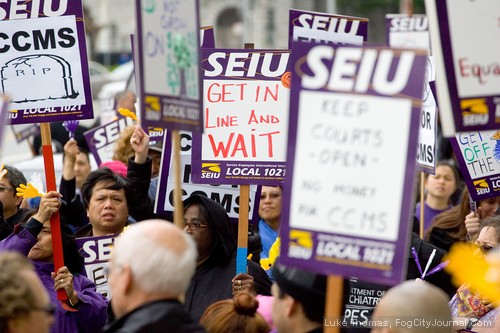
As many as 100 SEIU workers held a rally Tuesday outside the State Building in San Francisco to protest State overspending on a Court Case Management System that has cost taxpayers $1.9 billion and resulted in staff layoffs, courtroom closures and case delays. Photos by Luke Thomas.
By Kat Anderson, Freelance unit, Pacific Media Workers Guild and Fog City Journal
March 28, 2012
California’s court case management system, a project that was supposed to link all the court filing systems of the state’s 58 counties, making access to court documents efficient and user-friendly, has been killed by the Judicial Council, following a meeting Tuesday at the Administrative Office of the Courts in San Francisco.
The Court Case Management System (CCMS) is years overdue, 800 percent over budget and still not ready for primetime. Meanwhile, funding was diverted from court operations to pay for the massive cost overruns while the public experienced court closures and long delays in accessing justice.
Leading the charge against funding the CCMS further was the Alliance for California Judges, which said that the money had been squandered on an unworkable system while courts were being forced to close its courtroom doors due to sharp cuts in state court funds.
Hundreds of court workers and justice advocates have lost their jobs, while those left on skeleton staffs of the county clerk offices have suffered dwindling pay and unpaid furlough days over the last four years.
About 100 members of public employee union SEIU Local 1021, court workers, lawyers and others-in-solidarity, rallied outside the State Building in San Francisco yesterday, calling for the Judicial Council to demand that the Administrative Office of the Courts stop the “computers before people” boondoggle.
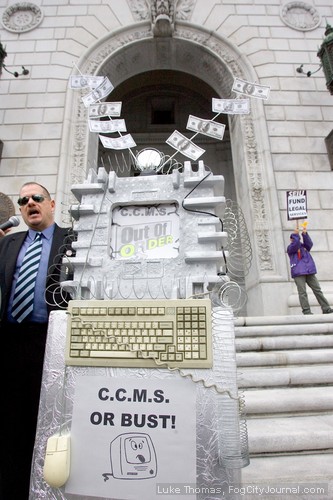
Tim Lavorini created an artful symbol of government waste.
“CCMS is not a fable like the Emperor’s new clothes, where some Emperor bought into the idea that this lovely computer system would solve all their problems. It’s not,” said Tim Lavorini, San Francisco superior court clerk, addressing fellow protesters. “We have seen the face of the ship’s captain asleep at the wheel and the ship has run aground. We cannot continue to do this to the citizens of California. We cannot continue to throw good money after bad.”
San Francisco City Attorney Dennis Herrera added, “Thank you for fighting for a vital, third branch of government that continues to serve the people of the state of California, providing equal access to justice for everybody.”
“Some folks don’t want to pay attention to what’s going on in the courts,” continued Herrera, “but everyday ordinary people are affected by what goes on in the courts, like marital rights, protecting children and health care. It is crucial to make sure there are people over machines to put a human face on what happens in the courts.”
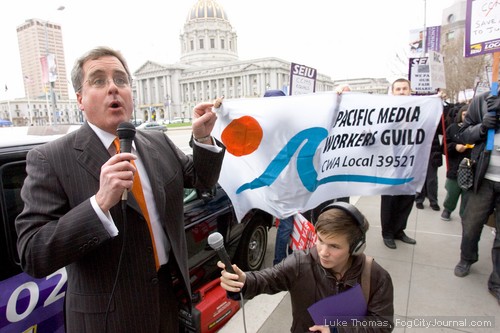
San Francisco City Attorney Dennis Herrera.
Brandon Scovill, Pacific Media Workers Guild, CWA Local 39521, and representative for the California Federation of Interpreters, addressed the crowd.
“There are over 800 court interpreters throughout the state,” Scovill said. “The courts, the employers, try to drive a wedge between the groups working at the courts, but we are here to show that we support each other, all the court workers. We are here in solidarity with SEIU Local 1021.”
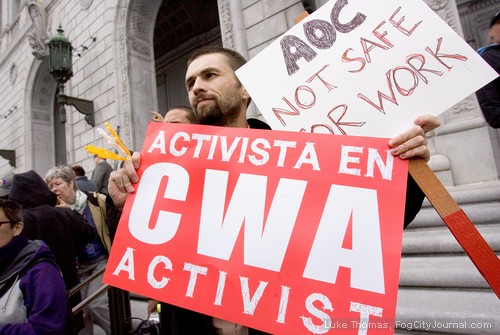
Brandon Scovill.
Outside vendors and consultants claim the system, which has cost $500 million so far, does and can work. They tout the virtues of a networked, paperless system that requires less court staff. In its defense, Jon Streeter, representing the State Bar, said, “Those of us who have practiced in other states know that we are falling behind. California will become, if this system is suspended or abandoned, one of the states that brings up the rear in terms of automation nationwide. We should not be in that position. We should be leading.”
The dismal fiscal reality faced by California, and unending cost overruns on the project, was too much to bear. A plan to link 11 counties this year, starting with San Luis Obispo, was estimated to cost $119 million over two years. However, a legislative panel recently voted not to fund this. The entire program, originally estimated at $206 million, could have ballooned to $1.9 billion by the time all the courts were linked.
Weighing whether to go forward, suspend the program for a year, or abandon it, the Judicial Council went for the coup de grace. Instead, the Council decided to retain the CCMS for the 7 counties that are already linked, and urged judicial managers to explore uses of existing technology. The Council authorized up to $8.7 million for this scaled-back plan.
There will be a rally to support funding the courts on April 18, 2012 at noon on the Polk Street steps of San Francisco City Hall. Attorney General Kamala Harris will joined by Mayor Ed Lee, President of the Board of Supervisors David Chiu, and speakers for SEIU, Consumer Attorneys and the San Francisco Building and Construction Trades Council.
More Photos
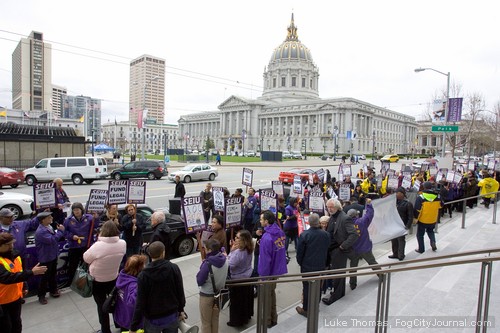

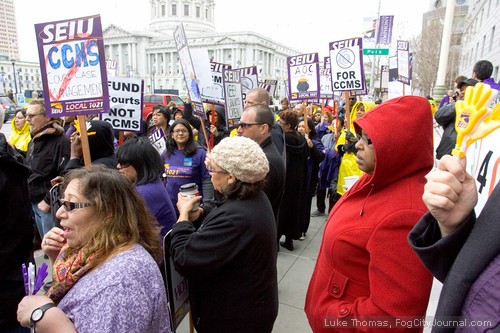
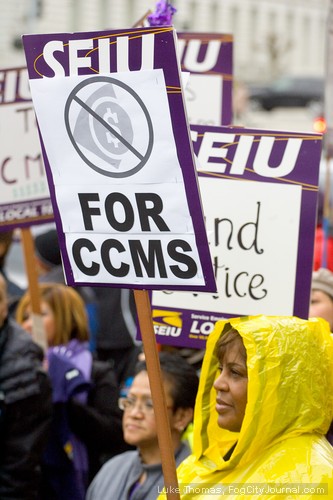
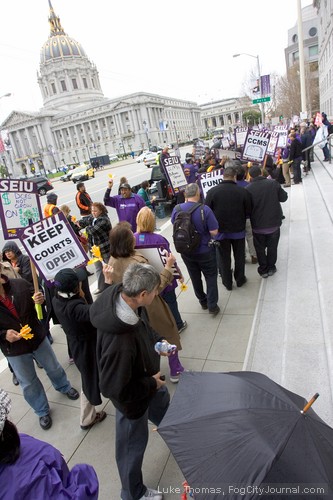
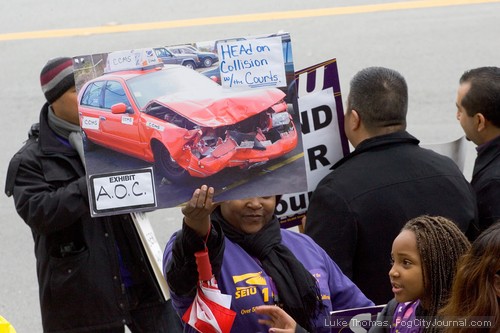
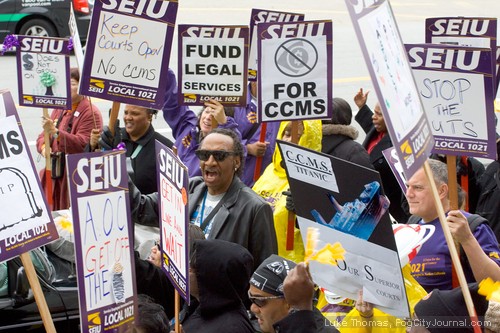
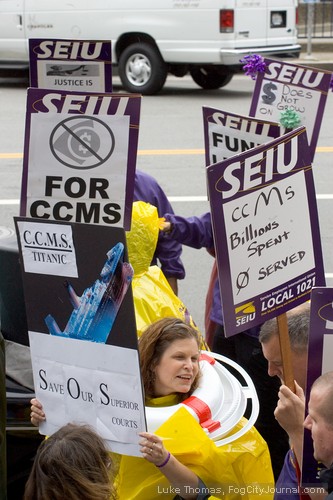
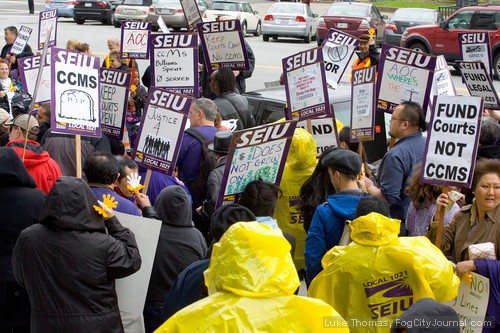


 The Hunger Site
The Hunger Site
March 29, 2012 at 1:47 am
This reminded me of the famous failed DMV computer system. That was only a $44M fiasco but of course it happened a couple of decades ago.
http://articles.latimes.com/1994-04-27/news/mn-50941_1_modernization-project
March 28, 2012 at 4:35 pm
Great demo, great pics’. And I’ve seen how jammed the courts are.
March 28, 2012 at 3:05 pm
History has shown that public works projects have a very poor record of coming in on time and on budget and that no one is held responsible. One of the more famous projects gone awry is Boston’s Central Artery/Tunnel Project know as the “Big Dig.” The 7.5 miles of underground roads that were to cost $2.8 billion ended up costing $14.5 billion before interest payments. With interest costs on the bonds added, the final cost was $22 billion. It will take Massachusetts until 2138 to pay off the debt. Locally, there are fairly recent two examples of projects running over time and over budget. The Muni’s T 3rd Street light rail line, originally estimated to cost $648 million, ran more than $150 million over budget and more than a year behind schedule. The rebuilding of the 4th Street Bridge, part of the T 3rd Street route, was originally to cost $17 million with an 18 month construction time. The actual cost was over $36 million. The construction time was three years. This is just another in the series of public projects gone bad.